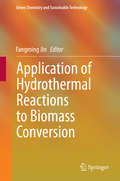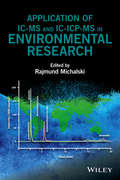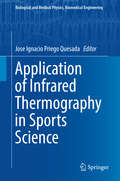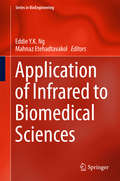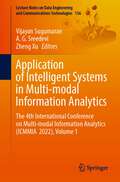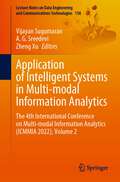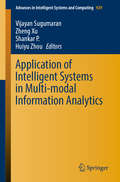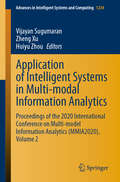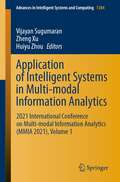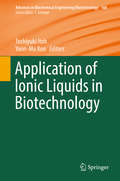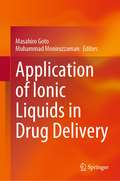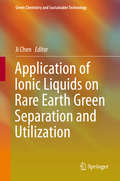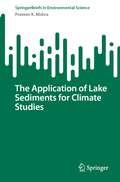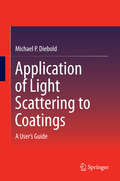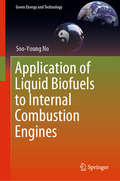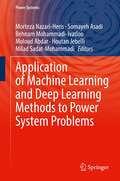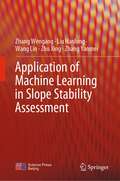- Table View
- List View
Application of Hydrothermal Reactions to Biomass Conversion (Green Chemistry and Sustainable Technology)
by Fangming JinThis book reviews the recent advances in hydrothermal conversion of biomass into chemicals and fuels, and consists of 15 chapters. It introduces the properties of high-temperature water, the merits of hydrothermal conversion of biomass, and some novel hydrothermal conversion processes, mainly including hydrothermal production of value-added products, hydrothermal gasification, hydrothermal liquefaction and hydrothermal carbonization. This book introduces a new concept for counteracting the imbalance in the carbon cycle, which is caused by the rapid consumption of fossil fuels in anthropogenic activities in combination with the slow formation of fossil fuels. Accordingly, the book is useful in conveying a fundamental understanding of hydrothermal conversion of biomass in the carbon cycle so that a contribution can be made to achieving sustainable energy and environment. It is also interesting to a wide readership in various fields including chemical, geologic and environmental science and engineering. Fangming Jin is a Distinguished Professor at the School of Environmental Science & Engineering, Shanghai Jiao Tong University, China
Application of IC-MS and IC-ICP-MS in Environmental Research
by Rajmund MichalskiIntroduces the reader to the field of ion chromatography, species analysis and hyphenated methods IC-MS and IC-ICP-MS including the theory and theirs applications Covers the importance of species analysis and hyphenated methods in ion chromatography Includes practical applications of IC-MS and IC-ICP-MS in environmental analysis Details sample preparation methods for ion chromatography Discusses hyphenated methods IC-MS and IC-ICP-MS used in determining both the total element contents and its elements Details speciation analysis used in studying biochemical cycles of selected chemical compounds; determining toxicity and ecotoxicity of elements; food and pharmaceuticals quality control; and in technological process control and clinical analytics
Application of Infrared Thermography in Sports Science (Biological and Medical Physics, Biomedical Engineering)
by Jose Ignacio Priego QuesadaThis book addresses the application of infrared thermography in sports, examining the main benefits of this non-invasive, non-radiating and low-cost technique. Aspects covered include the detection of injuries in sports medicine, the assessment of sports performance due to the existing link between physical fitness and thermoregulation and the analysis of heat transfer for sports garments and sports equipment. Although infrared thermography is broadly considered to be a fast and easy-to-use tool, the ability to deliver accurate and repeatable measurements is an important consideration. Furthermore, it is important to be familiar with the latest sports studies published on this technique to understand its potential and limitations. Accordingly, this book establishes a vital link between laboratory tests and the sports field.
Application of Infrared to Biomedical Sciences (Series in BioEngineering)
by Eddie Y. K. Ng Mahnaz EtehadtavakolThe book covers the latest updates in the application of infrared to biomedical sciences, a non-invasive, contactless, safe and easy approach imaging of skin and tissue temperatures. Its diagnostic procedure allows practitioners to identify the locations of abnormal chemical and blood vessel activity such as angiogenesis in body tissue. Its non-invasive approach works by applying the technology of the infrared camera and state-of-the-art software, where high-resolution digital infrared imaging technology benefits highly from enhanced image production, standardized image interpretation protocols, computerized comparison and storage, and sophisticated image enhancement and analysis. The book contains contributions from global prominent scientists in the area of infrared applications in biomedical studies. The target audience includes academics, practitioners, clinicians and students working in the area of infrared imaging in biomedicine.
Application of Integrable Systems to Phase Transitions
by C. B. WangThe eigenvalue densities in various matrix models in quantum chromodynamics (QCD) are ultimately unified in this book by a unified model derived from the integrable systems. Many new density models and free energy functions are consequently solved and presented. The phase transition models including critical phenomena with fractional power-law for the discontinuities of the free energies in the matrix models are systematically classified by means of a clear and rigorous mathematical demonstration. The methods here will stimulate new research directions such as the important Seiberg-Witten differential in Seiberg-Witten theory for solving the mass gap problem in quantum Yang-Mills theory. The formulations and results will benefit researchers and students in the fields of phase transitions, integrable systems, matrix models and Seiberg-Witten theory.
Application of Intelligent Control Algorithms to Study the Dynamics of Hybrid Power System (Studies in Systems, Decision and Control #426)
by Dipayan Guha Provas Kumar Roy Subrata Banerjee Shubhi PurwarThis book aims to systematically review and design different intelligent control algorithms for the small-signal stability assessment of HPS. With the growing consciousness of global warming and the fast depletion of natural power generation resources, the existing power system is on the verge of transitions to a “hybrid power system (HPS)” integrated with distributed energy resources. The recent results and requirements for the developments of intelligent control algorithms have motivated the authors to introduce this book for extensively analyzing the performance of HPS against unknown/uncertain disturbances. This book introduces fractional-order resilient control methodologies for arresting small-signal instability of HPS. The prospective investigation has been performed on the MATLAB platform. This book is helpful for undergraduate, postgraduate students, and research scholars working in power system stability, control applications, and soft computing in particular.
Application of Intelligent Systems in Multi-modal Information Analytics: The 4th International Conference on Multi-modal Information Analytics (ICMMIA 2022), Volume 1 (Lecture Notes on Data Engineering and Communications Technologies #136)
by Vijayan Sugumaran A. G. Sreedevi Zheng XuThis book provides comprehensive coverage of the latest advances and trends in information technology, science, and engineering. Specifically, it addresses a number of broad themes, including multimodal informatics, data mining, agent-based and multi-agent systems for health and education informatics, which inspire the development of intelligent information technologies. The contributions cover a wide range of topics such as AI applications and innovations in health and education informatics; data and knowledge management; multimodal application management; and web/social media mining for multimodal informatics. Outlining promising future research directions, the book is a valuable resource for students, researchers, and professionals and a useful reference guide for newcomers to the field. This book is a compilation of the papers presented in the 4th International Conference on Multi-modal Information Analytics, held online, on April 23, 2022.
Application of Intelligent Systems in Multi-modal Information Analytics: The 4th International Conference on Multi-modal Information Analytics (ICMMIA 2022), Volume 2 (Lecture Notes on Data Engineering and Communications Technologies #138)
by Vijayan Sugumaran A. G. Sreedevi Zheng XuThis book provides comprehensive coverage of the latest advances and trends in information technology, science and engineering. Specifically, it addresses a number of broad themes, including multi-modal informatics, data mining, agent-based and multi-agent systems for health and education informatics, which inspire the development of intelligent information technologies. The book covers a wide range of topics such as AI applications and innovations in health and education informatics; data and knowledge management; multi-modal application management; and web/social media mining for multi-modal informatics. Outlining promising future research directions, the book is a valuable resource for students, researchers and professionals and a useful reference guide for newcomers to the field. This book is a compilation of the papers presented in the 4th International Conference on Multi-modal Information Analytics, held online, on April 23, 2022.
Application of Intelligent Systems in Multi-modal Information Analytics (Advances in Intelligent Systems and Computing #929)
by Vijayan Sugumaran Zheng Xu Shankar P. Huiyu ZhouThis book presents the proceedings of the 2019 International Conference on Intelligent Systems Applications in Multi-modal Information Analytics, held in Shenyang, China on February 19-20, 2019. It provides comprehensive coverage of the latest advances and trends in information technology, science and engineering, addressing a number of broad themes, including data mining, multi-modal informatics, agent-based and multi-agent systems for health and education informatics, which inspire the development of intelligent information technologies. The contributions cover a wide range of topics: AI applications and innovations in health and education informatics; data and knowledge management; multi-modal application management; and web/social media mining for multi-modal informatics. Outlining promising future research directions, the book is a valuable resource for students, researchers and professionals, and provides a useful reference guide for newcomers to the field.
Application of Intelligent Systems in Multi-modal Information Analytics: Proceedings of the 2020 International Conference on Multi-model Information Analytics (MMIA2020), Volume 1 (Advances in Intelligent Systems and Computing #1233)
by Vijayan Sugumaran Zheng Xu Huiyu ZhouThis book presents the proceedings of the 2020 International Conference on Intelligent Systems Applications in Multi-modal Information Analytics, held in Changzhou, China, on June 18–19, 2020. It provides comprehensive coverage of the latest advances and trends in information technology, science and engineering. It addresses a number of broad themes, including data mining, multi-modal informatics, agent-based and multi-agent systems for health and education informatics, which inspire the development of intelligent information technologies. The contributions cover a wide range of topics such as AI applications and innovations in health and education informatics; data and knowledge management; multi-modal application management; and web/social media mining for multi-modal informatics. Outlining promising future research directions, the book is a valuable resource for students, researchers and professionals, and a useful reference guide for newcomers to the field.
Application of Intelligent Systems in Multi-modal Information Analytics: Proceedings of the 2020 International Conference on Multi-model Information Analytics (MMIA2020), Volume 2 (Advances in Intelligent Systems and Computing #1234)
by Vijayan Sugumaran Zheng Xu Huiyu ZhouThis book presents the proceedings of the 2020 International Conference on Intelligent Systems Applications in Multi-modal Information Analytics, held in Changzhou, China, on June 18–19, 2020. It provides comprehensive coverage of the latest advances and trends in information technology, science and engineering. It addresses a number of broad themes, including data mining, multi-modal informatics, agent-based and multi-agent systems for health and education informatics, which inspire the development of intelligent information technologies. The contributions cover a wide range of topics such as AI applications and innovations in health and education informatics; data and knowledge management; multi-modal application management; and web/social media mining for multi-modal informatics. Outlining promising future research directions, the book is a valuable resource for students, researchers and professionals, and a useful reference guide for newcomers to the field.
Application of Intelligent Systems in Multi-modal Information Analytics: 2021 International Conference on Multi-modal Information Analytics (MMIA 2021), Volume 2 (Advances in Intelligent Systems and Computing #1385)
by Vijayan Sugumaran Zheng Xu Huiyu ZhouThis book provides comprehensive coverage of the latest advances and trends in information technology, science and engineering. Specifically, it addresses a number of broad themes, including multi-modal informatics, data mining, agent-based and multi-agent systems for health and education informatics, which inspire the development of intelligent information technologies. The contributions cover a wide range of topics such as AI applications and innovations in health and education informatics; data and knowledge management; multi-modal application management; and web/social media mining for multi-modal informatics. Outlining promising future research directions, the book is a valuable resource for students, researchers and professionals, and a useful reference guide for newcomers to the field. This book is a compilation of the papers presented in the 2021 International Conference on Multi-modal Information Analytics, held in Huhehaote, China, on April 23–24, 2021.
Application of Intelligent Systems in Multi-modal Information Analytics: 2021 International Conference on Multi-modal Information Analytics (MMIA 2021), Volume 1 (Advances in Intelligent Systems and Computing #1384)
by Vijayan Sugumaran Zheng Xu Huiyu ZhouThis book provides comprehensive coverage of the latest advances and trends in information technology, science and engineering. Specifically, it addresses a number of broad themes, including multi-modal informatics, data mining, agent-based and multi-agent systems for health and education informatics, which inspire the development of intelligent information technologies. The contributions cover a wide range of topics such as AI applications and innovations in health and education informatics; data and knowledge management; multi-modal application management; and web/social media mining for multi-modal informatics. Outlining promising future research directions, the book is a valuable resource for students, researchers and professionals, and a useful reference guide for newcomers to the field. This book is a compilation of the papers presented in the 2021 International Conference on Multi-modal Information Analytics, held in Huhehaote, China, on April 23–24, 2021.
Application of Ionic Liquids in Biotechnology (Advances in Biochemical Engineering/Biotechnology #168)
by Toshiyuki Itoh Yoon-Mo KooThis volume explores how ionic liquids are used in different areas of biotechnology. It also provides insights on the interaction of ionic liquids with biomolecules and biomaterials. Ionic liquids have become essential players in the fields of synthesis, catalysis, extraction and electrochemistry, and their unique properties have opened a wide range of applications in biotechnology. Readers will discover diverse examples of the application of ionic liquids as solvents for biomaterials extraction and pretreatment, in enzymatic and whole cell catalysed reaction, and as activation agents for biocatalysis. Particular attention is given to the biologically functionalized ionic liquids employed in medical and pharmaceutical applications. Although ionic liquids are considered “green solvents”, the contributing authors will also explore their environmental impact when applied to biotechnology. Chemical, biological and medical scientists interested in ionic liquids and biotechnology will find this work instructive and informative.
Application of Ionic Liquids in Drug Delivery
by Masahiro Goto Muhammad MoniruzzamanThis book presents recent advances in the use of ionic liquids in medicine and pharmaceutics with particular emphasis on addressing critical pharmaceutical challenges, including the low solubility, polymorphism, and bioavailability of drugs. It also provides insights into the development of the biologically functionalized ionic liquids suitable for medical and pharmaceutical applications. Ionic liquids have been used as potential solvents or materials in the fields of pharmaceutical drug delivery and formulations because of their unique and tunable physicochemical and biological properties. Readers find explanations of the diverse approaches to the application of ionic liquids in drug solubility, active pharmaceutical ingredient (API) formulation, and drug delivery systems, such as topical, transdermal, and oral delivery, with particular emphasis on recent developments. Particular attention is given to the development of ionic liquid-assisted effective drug delivery techniques for sparingly soluble or insoluble drug molecules. This book also discusses the biological activities of ionic liquids for possible applications in drug formulation and drug delivery systems. Scientists in disciplines such as chemistry, biology, and pharmaceutics find this book instructive and informative for developing ionic liquid-based drug formulations or drug delivery systems.
Application of Ionic Liquids on Rare Earth Green Separation and Utilization (Green Chemistry and Sustainable Technology)
by Ji ChenThis book comprehensively details the applications of ionic liquids in rare earth green separation and utilization based on the unique interactions of ionic liquids with rare earth ions. It consists of nine chapters demonstrating the synthesis and properties of ionic liquids, coordination chemistry of ionic liquids and rare earth, ionic liquids as diluents, extractants, adsorption resins for rare earth extraction and separation, electrodeposition of rare earth metals in ionic liquids, and preparation of rare earth material with the aid of ionic liquids. It is both interesting and useful to chemists, metallurgists and graduate students working on fundamental research of ionic liquids as well as professionals in the rare earth industry. It provides considerable insights into green chemistry and sustainable processes for rare earth separation in order to meet the environmental challenge of rare earth metallurgy around the globe, especially in China. Ji Chen is a Professor of Chemistry at the Changchun Institute of Applied Chemistry, Chinese Academy of Sciences, China.
The Application of Lake Sediments for Climate Studies (SpringerBriefs in Environmental Science)
by Praveen K. MishraThe book discusses a comprehensive overview of various limnological approaches for climate studies, and sheds light on a multi-dimensional approach (i.e., field, laboratory, and data analysis; modern investigations; proxy development/calibration; proxy interpretation; and validation of climate models with proxy data) for climate reconstruction. The study highlighted the utilization of lake sediment as an archive for paleoclimate research. With the help of several case studies from around the globe (Israel, India, Turkey, Kyrgyzstan, Tibet, China and Europe), this brief provides a unique way to understand the implication of the methodological framework for climate studies. The book emphasizes the importance of field-based modern investigations to establish baseline characteristics of lake basins according to changes in environmental conditions. It also unveils the role of paleoclimate studies in climate model validation to forecast future climate variability. The book is a valuable resource for early career researchers interested in climate studies especially those using lake sediments as climate archive.
Application of Lasers in Manufacturing: Select Papers From Aimtdr 2016 (Lecture Notes on Multidisciplinary Industrial Engineering)
by J. Paulo Davim Shrikrishna N. Joshi Uday Shanker DixitThis book mainly addresses the applications of lasers in the manufacture of various industrial components. The technologies presented here have scopes of application ranging from the macro to meso and micro level of components and features. This book includes chapters on the basic and advanced applications of lasers in the manufacturing domain. They present theoretical and practical aspects of laser technology for various applications such as laser-based machining, micro-scribing, texturing, machining of micro-sized channels; laser welding; laser-based correction of sheet metal, i.e. straightening; laser forming; and laser technology for 3-D printing. Lasers have various applications such as the production of powerful lights for illumination or decoration; measurement of velocity (transportation) and length; interferometry; printing; recording; communication; bio-medical instrumentation and pollution detection. A significant body of literature is available on the physics of lasers and types of lasers. However it has been noted there are a few books published on the “applications of lasers in manufacturing domain,” a gap that this book remedies. Gathering contributions by leading engineers and academicians in this area, it offers a valuable source of information for young scientists and research students.
Application of Light Scattering to Coatings: A User’s Guide
by Michael P. DieboldThe book begins with the fundamentals of light scattering, first by individual particles, then by small groups of particles, and finally by the trillions of particles present in a real-life paint film. From there, Dr. Diebold focuses on application of these fundamentals to paint formulation. The scope includes both theory and practice with an emphasis on application (from both performance and cost standpoints). The book gives a clear understanding of light scattering principles and application of these principles to paint formulation (with a focus on TiO2 - the strongest scattering material available to paint formulators). The reader will be in a position to formulate and reformulate paints for maximum cost effectiveness. Application of Light Scattering to Coatings: A Users Guide is ideal for a range of professions working in paint formulation and manufacturing. This book also: Distills difficult theories (light scattering, paint formulation) into easy-to-understand concepts Adopts a qualitative perspective, with minimal use of complex equations, making key scientific concepts accessible to all paint formulators without a prerequisite of higher mathematics Offers an accessible resource for formulators new to the field while maintaining a high degree of relevance to experienced coating formulators Discusses the interplay between resin, TiO2 pigments, and paint extenders with regard to paint performance and cost Presents an unbiased assessment of opacifying potential of TiO2 alternatives Outlines strategies for minimizing overall costs of paints.
Application of Lightweighting Technology to Military Vehicles, Vessels, and Aircraft
by National Materials and Manufacturing Board Division on Engineering and Physical Sciences Committee on Benchmarking the Technology and Application of Lightweighting National Research CouncilLightweighting is a concept well known to structural designers and engineers in all applications areas, from laptops to bicycles to automobiles to buildings and airplanes. Reducing the weight of structures can provide many advantages, including increased energy efficiency, better design, improved usability, and better coupling with new, multifunctional features. While lightweighting is a challenge in commercial structures, the special demands of military vehicles for survivability, maneuverability and transportability significantly stress the already complex process. Application of Lightweighting Technology to Military Vehicles, Vessels, and Aircraft assesses the current state of lightweighting implementation in land, sea, and air vehicles and recommends ways to improve the use of lightweight materials and solutions. This book considers both lightweight materials and lightweight design; the availability of lightweight materials from domestic manufacturers; and the performance of lightweight materials and their manufacturing technologies. It also considers the "trade space"--that is, the effect that use of lightweight materials or technologies can have on the performance and function of all vehicle systems and components. This book also discusses manufacturing capabilities and affordable manufacturing technology to facilitate lightweighting. Application of Lightweighting Technology to Military Vehicles, Vessels, and Aircraft will be of interest to the military, manufacturers and designers of military equipment, and decision makers.
Application of Liquid Biofuels to Internal Combustion Engines (Green Energy and Technology)
by Soo-Young NoThis book provides a comprehensive overview of the application of liquid biofuels to internal combustion (IC) engines. Biofuels are one of the most promising renewable and sustainable energy sources. Particularly, liquid biofuels obtained from biomass could become a valid alternative to the use of fossil fuels in the light of increasingly stringent environmental constraints. In this book, the discussion is limited to liquid biofuels obtained from triglycerides and lignocellulose among the many different kinds of biomass. Several liquid biofuels from triglycerides, straight vegetable oil, biodiesel produced from inedible vegetable oil, hydrotreated vegetable oil, and pyrolytic oil have been selected for discussion, as well as biofuels from lignocellulose bio-oil, alcohols such as methanol, ethanol and butanol, and biomass-to-liquids diesel. This book includes three chapters on the application of methanol, ethanol and butanol to advanced compression ignition (CI) engines such as LTC, HCCI, RCCI and DF modes. Further, the application of other higher alcohols and other drop-in fuels such as DMF, MF, MTHF, and GVL are also discussed. The book will be a valuable resource for graduate students, researchers and engine designers who are interested in the application of alcohols and other biofuels in advanced CI engines, and also useful for alternative energy planners selecting biofuels for CI engines in the future.
Application of Machine Learning and Deep Learning Methods to Power System Problems (Power Systems)
by Behnam Mohammadi-Ivatloo Morteza Nazari-Heris Somayeh Asadi Moloud Abdar Houtan Jebelli Milad Sadat-MohammadiThis book evaluates the role of innovative machine learning and deep learning methods in dealing with power system issues, concentrating on recent developments and advances that improve planning, operation, and control of power systems. Cutting-edge case studies from around the world consider prediction, classification, clustering, and fault/event detection in power systems, providing effective and promising solutions for many novel challenges faced by power system operators. Written by leading experts, the book will be an ideal resource for researchers and engineers working in the electrical power engineering and power system planning communities, as well as students in advanced graduate-level courses.
Application of Machine Learning in Slope Stability Assessment
by Zhang Wengang Liu Hanlong Wang Lin Zhu Xing Zhang YanmeiThis book focuses on the application of machine learning in slope stability assessment. The contents include: overview of machine learning approaches, the mainstream smart in-situ monitoring techniques, the applications of the main machine learning algorithms, including the supervised learning, unsupervised learning, semi- supervised learning, reinforcement learning, deep learning, ensemble learning, etc., in slope engineering and landslide prevention, introduction of the smart in-situ monitoring and slope stability assessment based on two well-documented case histories, the prediction of slope stability using ensemble learning techniques, the application of Long Short-Term Memory Neural Network and Prophet Algorithm in Slope Displacement Prediction, displacement prediction of Jiuxianping landslide using gated recurrent unit (GRU) networks, seismic stability analysis of slopes subjected to water level changes using gradient boosting algorithms, efficient reliability analysis of slopes in spatially variable soils using XGBoost, efficient time-variant reliability analysis of Bazimen landslide in the Three Gorges Reservoir Area using XGBoost and LightGBM algorithms, as well as the future work recommendation.The authors also provided their own thoughts learnt from these applications as well as work ongoing and future recommendations.
Application of Machine Learning Models in Agricultural and Meteorological Sciences
by Mohammad Ehteram Akram Seifi Fatemeh Barzegari BanadkookiThis book is a comprehensive guide for agricultural and meteorological predictions. It presents advanced models for predicting target variables. The different details and conceptions in the modelling process are explained in this book. The models of the current book help better agriculture and irrigation management. The models of the current book are valuable for meteorological organizations. Meteorological and agricultural variables can be accurately estimated with this book's advanced models. Modelers, researchers, farmers, students, and scholars can use the new optimization algorithms and evolutionary machine learning to better plan and manage agriculture fields. Water companies and universities can use this book to develop agricultural and meteorological sciences. The details of the modeling process are explained in this book for modelers. Also this book introduces new and advanced models for predicting hydrological variables. Predicting hydrological variables help water resource planning and management. These models can monitor droughts to avoid water shortage. And this contents can be related to SDG6, clean water and sanitation. The book explains how modelers use evolutionary algorithms to develop machine learning models. The book presents the uncertainty concept in the modeling process. New methods are presented for comparing machine learning models in this book. Models presented in this book can be applied in different fields. Effective strategies are presented for agricultural and water management. The models presented in the book can be applied worldwide and used in any region of the world. The models of the current books are new and advanced. Also, the new optimization algorithms of the current book can be used for solving different and complex problems. This book can be used as a comprehensive handbook in the agricultural and meteorological sciences. This book explains the different levels of the modeling process for scholars.
Application of Management Theories for STEM Education: The Case of SWOT Analysis (SpringerBriefs in Education)
by Orit Hazzan Einat Heyd-Metzuyanim Yehudit Judy Dori Anat Even-Zahav Tali TalThis work describes the application of management theories in STEM (Science, Technology, Engineering and Mathematics) education systems. Two chapters examine STEM education on the K-12 national level and one chapter focuses on the higher education institutional level. All chapters are based on comprehensive research. Thus, it will appeal to teachers, school principals, researchers, graduate students, government policymakers, and all practitioners who care about STEM education in schools, academia and government. In each chapter, SWOT (Strengths, Weaknesses, Opportunities, and Threats) analysis is used as a managerial strategic tool for the examination of factors that focus either on internal circumstances (strengths and weaknesses), or external ones (opportunities and threats).
